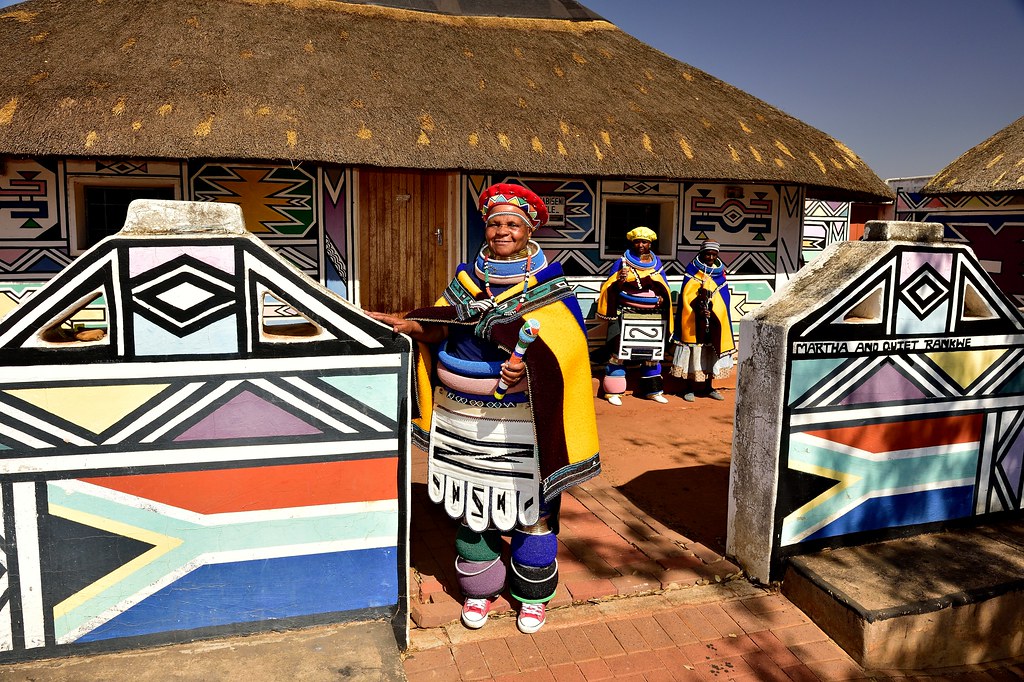Tribal Beauty | Ndebele Distinct Cultural Identity
Ndebele peoples culture

Southern and Northern African Ndebele people preserved their cultural identity. Art, life, and language profile for Ndebele of South African and Zimbabwe culture. Southern African Ndebele people maintained the use of the isiNdebele language, rituals, customs and art forms as a means of asserting their African Ndebele identity and resistance to outsiders.

Ndebele African people tribe art, history, and language.
Explore and Understand Africa Through Her Food and Culture
The Nguni tribes represent nearly two-thirds of South Africa's Black population divided into four distinct groups; the Central Nguni (the Zulu-speaking peoples), the Southern Nguni (the Xhosa-speaking peoples), the Swazi people from Swaziland and adjacent areas and the Ndebele people of the Northern Province and Mpumalanga.
Traditionally the Ndebele wife would wear rings called idzila as a status symbol around her arms, legs, and neck. These outward symbols can be removed only in case of death of the spouse. Idzila was worn by the wife to embody her until death does us part union and devotion to her husband.
Husbands used to provide their wives with the idzila rings. The more prosperous husbands could afford to by his wife more idzila rings thus the more rings the wife would wear the greater her status in the Ndebele community.
Today it is no longer common practice to wear these rings permanently. Over time, among the youngest populations, this custom to wear the idzila for a lifetime is disappearing. Each African culture is a unique answer to the question of what it means to be human. In today’s rapidly changing world, people from Africa worry about losing their traditional culture, the traditional way of life is getting lost.
One Ndebele beauty custom that has survived the modern way of life is elaborate wall paintings. The Ndebele wall paintings have a strong symbolic value and are closely linked to the home and to the relationship of the person. Women paint on the outside walls and sometimes also on the interior walls with rich geometric patterns learned from childhood. The walls are changed and repainted in particular moments of family life.
The South African Ndebele origins are unknown however, their history can be traced back to chief Mafana in the 1600’s. The Ndebele first officially recorded chief, chief Mafana was succeeded by chief Mhlanga.
The Ndebele second chief Mhlanga had a son named Musi who decided to leave his homeland. Chief Mhlanga did not name an heir and after his death, his two sons argued over the position and the tribe divided into two divisions, the Manala, and the Ndzundza.
Mampuru and 30 men murdered Mampuru's brother Sekhukune on August 23, 1882, he then went into hiding. Commandant General Piet Joubert was ordered to find Mampuru. Joubert located Mampuru after the Ndzundza tribe women were tortured into revealing his whereabouts at Erholweni Mapochs Caves on October 12, 1882.
It was only after the Boer forces with the aid of other tribal chiefs surrounded the caves cutting off food and water supplies. Mampuru was sentenced to death and died at the gallows on November 22, 1883, in Pretoria South Africa. The war was ended after eight months and one day, on July 8, 1883.
The First Boer War disturbed the cohesive tribal structure of the Ndzundza-Ndebele when they lost the battle and their tribal lands were confiscated. However, the Ndebele preserved their distinct cultural identity. They maintained the use of the isiNdebele language, rituals, customs and art forms as a means of asserting their cultural identity and resistance to outsiders.
Ndebele wall paintings have strong symbolic value and are closely linked to the home and to the relationship of the person within. Ndebele Women paint on the outside walls and sometimes also on the interior with rich geometric patterns.
The walls are changed and repainted in particular moments of family life. This art form has developed in the second half of the nineteenth century, using bright of the brightest colors. Earth tones were used in the past.
There are three main groups of Ndebele people; The Southern Transvaal Ndebele (now Gauteng and Mpumalanga) The Northern Transvaal Ndebele (now Limpopo Province) around the towns of Mokopane (Potgietersrus) and Polokwane (Pietersburg). The Ndebele people of Zimbabwe, who were called the Matabele by the British.
Together we build awareness that boost harmony, education, and success, below are more links to articles you will find thought provoking.
- Deadliest routes for refugees
- Cooking with shea butter oil
- Worst serial killers recorded in history are women
- Indigenous healers and plants used
- Night running illness or magic
- What is back to Africa



